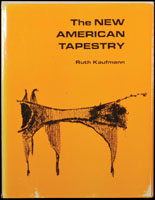“Americans were late arrivals in the field of tapestry weaving, which may account to some degree for the fact that the American tapestry weaver is less bound by tradition than his European colleague. His historical background, however, is probably the major factor. He projects into his work some of the dynamic exploratory spirit and inventiveness that are part of his pioneer past. He feels free to investigate, to challenge old established methods, and to extend the many possibilities of his medium. Furthermore, instead of undergoing the discipline of apprenticeship, he is in most instances trained in the art and craft departments of universities. Exposure to the entire field of art, its interaction and overlapping, results in a broader, more sophisticated attitude….
Although our American artist-weavers have assimilated ideas from other countries, other times, and other art media, they have translated and utilized these entirely in terms of their own identity. A compelling new form of weaving has recently appeared as a result of their unhampered experimentation — free hanging two- and three-dimensional woven objects. These stunning sculptural creations have refused to stay passively on the wall. Instead, they have moved into space. Enthusiastically received by weavers and art lovers here and abroad, they have added a promising new dimension to the craft.”
Ruth Kaufmann
The New American Tapestry
(Reinhold Book Corporation, NY.Amsterdam.London, 1968, pp. 10-11)

Born and educated in Germany, Ms. Kaufmann studied fashion and design, textile design under Lili Blumenau, rug-weaving with with designer Margit Pardo, and tapestry weaving with renowned artist Martta Taipale of Finland. In 1968, Ms. Kaufmann was one of the American tapestry weavers who exhibited with American Craftsman, Inc. in New York. In 1969, she opened the Ruth Kaufmann Gallery in New York.


